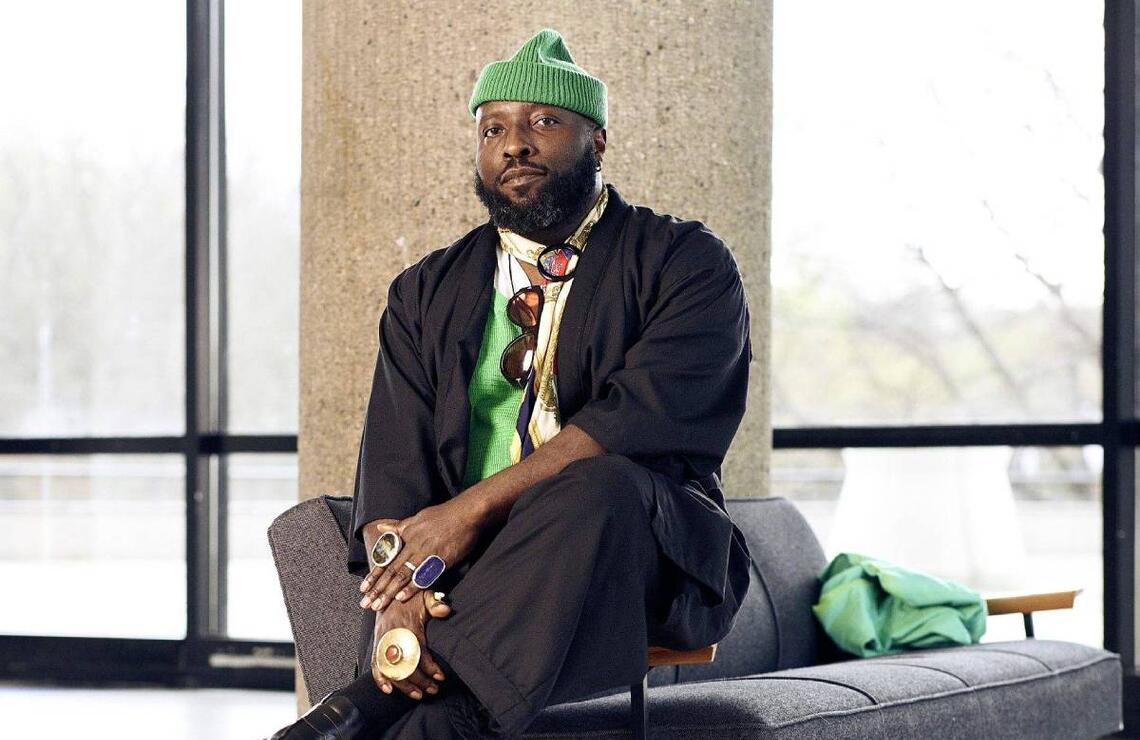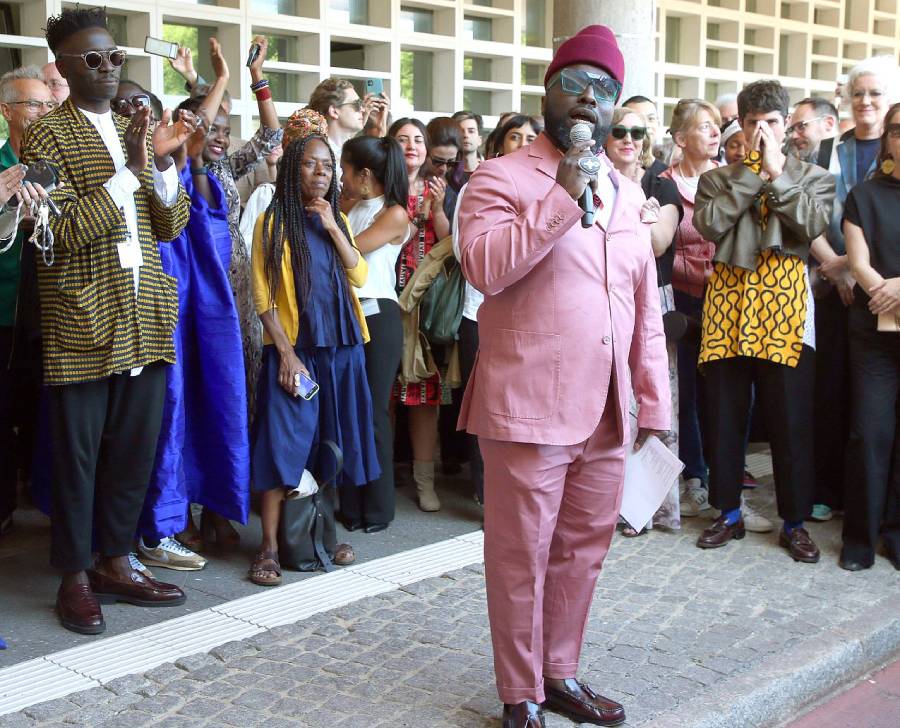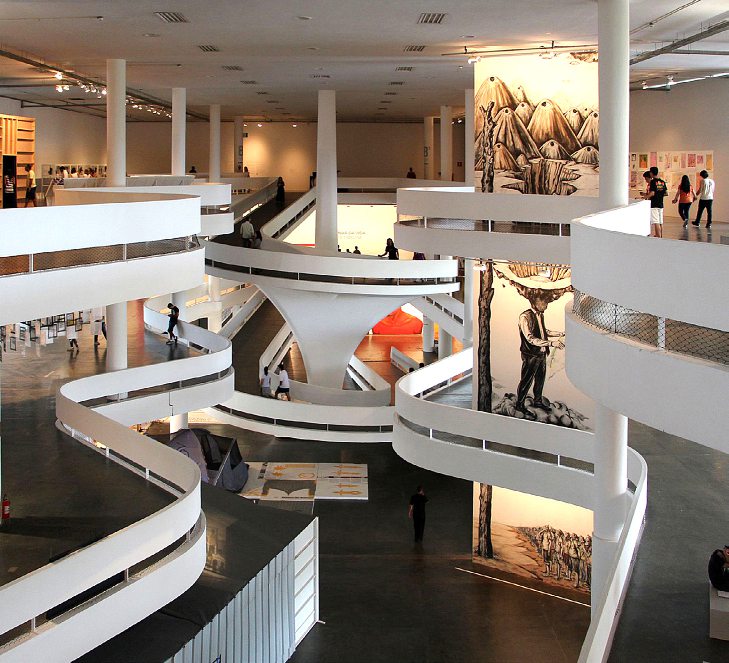
Bonaventure Soh Bejeng Ndikung
“Art cannot be anything but political”
Bonaventure Soh Bejeng Ndikung, head of Berlin's prestigious Haus der Kulturen der Welt, campaigns for authentically African art rooted in the continent and powerfully contemporary so that it can be part of the world. A frank and direct interview.
Bonaventure Soh Bejeng Ndikung is a commissioner, a curator and a guide, championing art in the multiplicity of its origins, and in its political and radical diversity. Showing ‘the other’ in his or her vitality, creativity and contribution to a ‘pluri-universal’ world. This child of Yaoundé (where he was born) and Bamenda (where he comes from), in Cameroon, has been running the Haus der Kulturen der Welt (House of World Cultures) since January 2023. The famous Berlin institution is dedicated to showcasing contemporary international art in a city that is home to no fewer than 170 nationalities. Bonaventure Soh Bejeng Ndikung has a great deal of experience. He has taken part in Documenta 2014, the Dakar Biennale, the Venice Biennale (in 2019, in the Finnish pavilion) and Bamako Encounters, among others. He constantly travels the world in search of artists, creators and concepts. In 2009, he opened SAVVY in Berlin, a veritable cultural laboratory on artistic diversity. He came to Germany in 1997 to do a PhD in medical biotechnology and biophysics, and stayed. The country offers a great deal of freedom to a curator intent on creating a dialogue between Western, African and Asian art. His next stop, in October 2025, will be the São Paulo Biennale, the largest biennale in the South for which he is, of course, the curator.
AM: We never say European or American contemporary art. Can one really speak of contemporary African art, or should art be considered universal?
Bonaventure Soh Bejeng Ndikung: I don't believe in universalism. In my opinion, there are many universalisms in different geographical areas, which can interact and be woven together, but which have different points of origin and anchorage. Singular universalism is a concept imposed by the West. We prefer the notion of ‘pluriversalism’. Contemporary European art is just called ‘contemporary art’, even though it emanates from a regional essence. But because this is universalism, they want to impose its global nature on us. Of course contemporary African art exists. Bili Bidjocka presented a piece at the 2007 Venice Biennale entitled 'African Art, What For?'. It was an essential provocation. And we've thought a lot about this theme over the last fifteen or twenty years. For me, it's simple: just as there is contemporary European and American art, there is also contemporary African art. What keeps us together is our contemporaneity, the same space-time of ideas and references, the fact that we are ‘living’ at the same time.
Are we talking about contemporary African art or a multitude of contemporary arts?
Like the concept of African fractals, the part is in the whole and the whole is the part. Multitudes are a given. In Cameroon, we have two hundred and thirty languages, and therefore just as many artistic expressions. This diversity is a source of wealth. Art exists in the same way as different epistemologies. And if there is a plurality of African epistemologies, then there is also a plurality of artistic expressions.
What distinguishes Africa from other cultural expressions around the world?
It would be too simplistic to focus on the differences. But if I had to highlight something specific, it would be the question of urgency. It's a theme you'll find in Latin America, Asia and the Middle East, and it's called agency and urgency. The relationship with all the crises that surround us – the environment, war, violence – and the strong understanding that beauty and aesthetics are also political. Our uniqueness also lies in our relationship with indigenous epistemology. An artist, say Yoruba or Ewe, will often draw inspiration from his indigenous voice – not systematically, but the link is possible. Take Olu Oguibe and his work for Documenta 14 in 2017. He proposed Biafra Time Capsule, a particularly powerful installation that reminded us of the crisis, war, struggle and independence of Biafra, Nigeria. He used sound, images and what he found in the archives. It's a contemporary work about urgency, but it's also a work set in a specific history.
What can be done to make contemporary African art better known outside the continent?

First of all, this art form needs to be recognised in Africa. And then we'll see... One of the aspects of neo-colonialism is that Africans tend to accept what comes from the outside world and don't give a damn about what happens at home. And the trap of capitalism pushes you towards an industrially rich model. But true independence begins with culture. That's why Amílcar Cabral stressed that culture lies at the heart of emancipation. He explained that we must create, exhibit and work in Africa. That's really all that matters. Then there's the question of the international dimension.
So art is necessarily political?
Art cannot be anything but political. All expression is political. This interview is political too.
Traditional and contemporary art are often compared. What is your view on this? Are the two linked, in your opinion?
That's another colonial problem. We have been disconnected, but the links are strong, they exist. An artist like Amina Agueznay in Morocco works with carpets and weaving in her sculptures, linking them with the ancient weavings of Berber women. There is no break between the traditional and the contemporary, because tradition also exists now, at all times. It doesn't just belong to the past. We are the bearers of our traditions, and trying to distinguish between the ancestral and the modern is a distraction.
I'm particularly thinking of traditional art galleries, which can be quite successful...
There's room for everyone. Some people trade in 15th and 16th century art, and that's fine. I'm talking about artists. What interests me are those who establish the link between the past and the present, and who understand that the past exists within the present. For example, Sammy Baloji, a Congolese artist, has worked with Kuba Showa signs and motifs, which he also uses in his contemporary pieces. He tries to understand what all these symbols and geometric shapes mean. And therein lies the problem: we want to divide time, even though it is indivisible.
Are you able to achieve this connection in Germany, from a Western institution funded by a Western state?
We mustn't forget that Berlin is forever linked to the continent, since it’s where Africa was divided up in 1884. So I see my work at HKW as part of a wider mission to understand and promote African knowledge and histories. This can and must be done from Cameroon and other countries. Germany has the means, it provides the funding and the opportunity to promote culture. The state has a responsibility to fund culture... I run the largest art centre in Germany, and I have public funds at my disposal. And my mandate is to develop a House of World Cultures. I can invite artists from all over the world and, if the concept is that I should show a piece that is two hundred years old, yes, I can do that and I will show it.
Are our Western friends impervious to your skin colour (are they colour-blind)? Do they see you as just a curator or as a Cameroonian curator in their own country?
Well... What’s clear is that they see an African, a Cameroonian. That's normal. In fact, ever since I was appointed head of this institution in 2021, there has been no end of controversy. The far right, and other people too, did everything to prevent me taking up this position... Not to mention all the excuses used to oust me. But, as Toni Morrison said, racism is a distraction. I don't have time to worry about it. I've got work to do. I have to act, be the medium that shows that we have knowledge, ancestral cultures that are powerful and contemporary. We aren’t stuck in the past. We exist now. Despite colonialism, we are present, we participate in the world's culture and sciences. In Europe, much of the cultural scene has become so redundant. Just look at what's happening in São Paulo, at the Lubumbashi Bienniale, in Dakar and Bamako. What's happening in these so-called ‘peripheral’ places is more important, more contemporary, more interesting than what's going on in the supposed centres... This truth has to be said.*
However, this year's Venice Biennale was an attempt to be more open. Don't you think that the theme of the 60th edition, Foreigners Everywhere, reflects a desire to open up to the world?
This Biennale allowed us to show artists from around the world. That's all very well, but it's not the point. There are Beninese, Nigerian, Senegalese and Ivorian pavilions... But the question remains: is the national museum in Lagos up and running? And the national museum in Abidjan? Let me come back to the essential point: the process must start at home. If we do it in Africa, we can do it elsewhere. I can give the example of Zimbabwe. Despite the country's difficulties, the national gallery in Harare is working well under the direction of Raphael Chikukwa. It's one of the few African countries, along with Egypt, that is doing consistent work. They're trying to solidify the base at home, to structure their institutions, and then they say: “If there's a biennale that wants to represent the nations, we'll go too”, just like the Olympic Games. I repeat: it has to start at home. If there's no electricity in the national galleries of the big cities in Africa, but you have to spend a mountain of money to get to Venice, I don't think that's very productive.
But the Biennale remains a major vehicle for exposure. It's like taking part in the Olympics is worth it. Does that justify the investment?
Yes, as long as you also work from home. It's worth it, because we exist in the world. Édouard Glissant said that each and every identity is extended through a relationship with the Other, that is the poetics of relation. We have to show what we are doing. We don't know each other. And art and culture give others the opportunity to get to know us, and us to get to know others. We cannot live separately; the concept of independence does not exist. The biennales of the world, whether in Dakar, Bamako, Venice or São Paulo, showcase art and facilitate encounters. They are structures of interdependence. Our knowledge depends on that of others. They are linked.
What is the main difference with São Paulo, where you are chief curator for this edition (September 2025)? How is this biennale different from the traditional circuit?

It's a biennale like any other. The difference lies in the fact that it is the largest in the South. And in its educational aspect. It was created to transmit culture and knowledge to the different demographics of the city of São Paulo. It began a bit like Venice, with national pavilions. But with Lisette Lagnado's 2006 edition, they moved away from representation through the idea of the nation-state. The São Paulo Biennale is open. I can invite artists from China, Cameroon, South Africa, Scandinavia, the four corners of the globe. They won't be there to represent their country, but to showcase art and culture... If it's linked to their country, so much the better and it doesn't matter.
And are there any bridges between the Souths?
This idea of bridges is a major one. Hence the importance of São Paulo, the biggest biennale of the South. My idea, my ambition, is to multiply the links between our artists and our institutions, to strengthen our power and influence. Because there is a global gradient of power, a scale on which we must progress.
What are the various stages between now and the opening of the São Paulo Biennale?
The opening will take place on 5 September 2025, and in October 2024 we will announce the Biennale's theme and collaboration venues. Then we'll carry out what we call our invocations: meetings in Asia, Latin America and Africa, where we invite artists from Asia, Africa and America, poets, writers and activists, to discuss the theme. I'm very interested in the concept of archives. For me, the question now is: how to disrupt and reinvent archives? That's the first thing, and the other is to create new ones.
What would you say to someone who says: “It's great that Bonaventure has theories, but why doesn't he invest at home? Why doesn't he put some of his money, his knowledge, into Cameroon?”
Whoever is asking this question is not familiar with my work. If they were interested, they would know that I have worked from Cairo to Cape Town, from Dakar to Antananarivo, that I have held two biennales in Bamako, in 2019 and 2022. I was co-curator of the Dakar Biennale, I've worked in Accra, in Cape Town with the Zeitz MOCAA, in Antananarivo with the Fondation H... We set up an institution in Limbé, in Cameroon, where there is constant violence, called SAVVY Kwata, with 6,000 books. It's one of the only cultural institutions in Limbé. Every year, I give lectures at more than a dozen universities across the continent. And by working all over the world, I'm also, in my own small way, spreading the word about Africa all over the world.
How do you feel today?
I'm hopelessly optimistic. I'm too optimistic, at the risk of not being able to do my job... Desperation is a luxury. And I don't have that luxury. I come from a part of Cameroon where war has been raging for eight years. My parents went into exile. My father died far from home. So I don't have the luxury of crying. Instead, I do. Because I have to do. Not just for our generation, but above all for posterity.